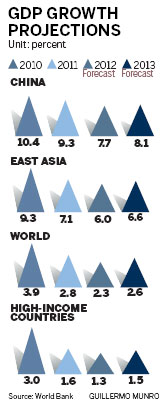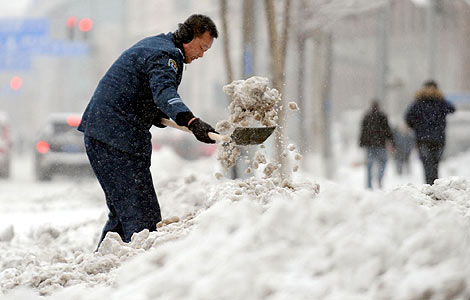
Major stimulus unlikely but risk of hard landing remains small: report
Growth may fall to 7.7 percent this year on the back of weak exports and slow investment, but a major stimulus is unlikely amid inflation concerns, the World Bank said on Monday.
The growth forecast, the lowest this decade, was 0.5 percentage points lower than an estimate made by the Washington-based lender in April.
The World Bank also lowered China's growth forecast in 2013 to 8.1 percent, from 8.6 percent. The global lender expects developing economies in East Asia to grow slower.
|
 |
"China is experiencing a double whammy - the growth slowdown is driven by weaker exports as well as domestic demand, in particular investment growth," Bert Hofman, World Bank chief economist for East Asia and the Pacific, said at a briefing in Singapore.
Although there was a risk the slowdown in China could worsen and last longer than many analysts forecast, Hofman stressed that the World Bank still expects China to have a soft landing.
The forecast was based on the bank's East Asia and Pacific Data Monitor released on Monday.
The report said that ambitious investment plans announced by several local governments in China could face funding constraints, "not least because governments are feeling the pinch of a cooling real estate market, which lowers land sales revenues".
"As policymakers try to balance their support for growth with their concerns of a rebound in housing prices and of a reversal of hot money flows from the third round of quantitative easing in the US, a major fiscal stimulus package is unlikely," the bank said.
Property prices in major cities climbed further in September, the fourth consecutive rise, according to the China Index Academy on Monday.
Easing monetary measures introduced in some countries, especially the United States, are expected to boost capital flow to developing countries and boost commodity prices.
"As a result, (China's) economic momentum is expected to be weak during the coming months, because of limited policy easing, a property market correction and faltering external demands," according to the World Bank report.
The forecast adjustment by the World Bank was the latest in a series of growth downgrades.
The Asian Development Bank recently cut its growth estimate for China to 7.7 percent from 8.5 percent.
"The Chinese government has the means to cushion the economy from global turmoil ... but it needs to expedite its effort to diversify the source of growth and strengthen structural reforms for inclusive growth," ADB chief economist Changyong Rhee said in a news release.
"Judging from the domestic economic performance in the third quarter, the effects of pro-growth policies are not yet clear," said Lian Ping, chief economist at the Bank of Communications.
Lian estimates that economic growth will dip to 7.5 percent in the third quarter, and 7.8 percent for the fourth quarter, but the yearly target of 7.5 percent can still be accomplished.
The fall is the result of external factors and the government is unlikely to issue another 4-trillion-yuan ($636 billion) stimulus as in 2008, he said.
Wang Tao, chief economist with UBS AG who estimate growth for the third quarter will slow to 7.3 percent, says key indicators are not favorable.
"Demand remains weak, and the factories are still reducing stock, so a recovery is not yet in sight," Wang said.
"But on the bright side, we estimate growth in credit supply to pick up in September, and so will housing sales and infrastructure investment," Wang said.
According to the World Bank, measures taken on the monetary front earlier this year are boosting credit, and data on industrial activity suggest a rebound.
"We therefore believe that the risk of a hard landing remains small," the bank said.
"The East Asia and Pacific region's share in the global economy has tripled in the last two decades, from 6 percent to almost 18 percent today, which underscores the critical importance of this region's continued growth for the rest of the world," said World Bank President Jim Yong Kim.
Pamela Cox, World Bank East Asia and Pacific Regional vice-president said that "weaker demand for East Asia's exports is slowing the regional economy, but compared to other parts of the world, it's still growing strongly".
Helen Qiao, an analyst with Morgan Stanley Asia said in a research note that "new exports orders still hovered in contraction territory in September, which suggests that the traditionally strong seasonal demand from Christmas orders could come in weaker than expected this year".
Reuters and Bloomberg contributed to this story.
weitian@chinadaily.com.cn







